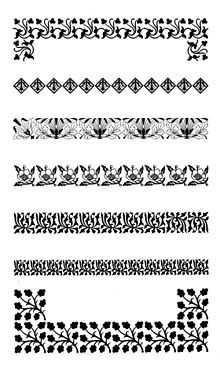Fleuron (typography)

| ❧ | |
|---|---|
|
Fleuron (typography) | |
A fleuron is a typographic element, or glyph, used either as a punctuation mark or as an ornament for typographic compositions. Fleurons are stylized forms of flowers or leaves; the term derives from the Old French word floron for flower.[1] Robert Bringhurst in The Elements of Typographic Style calls the forms "horticultural dingbats."[2] It is also known as a printers' flower, or more formally as an aldus leaf (after Italian Renaissance printer Aldus Manutius), hedera leaf, or simply hedera (ivy leaf) symbol.
History

One of the oldest typographic ornaments, in early Greek and Latin texts, the hedera was used as an inline character to divide paragraphs, similar to the pilcrow.[3] It can also be used to fill the whitespace that result from the indentation of the first line of a paragraph,[4] on a line by itself to divide paragraphs in a highly stylized way, to divide lists, or for pure ornamentation.[5]
In more modern historic books, line breaks became more common as paragraph dividers, and fleurons became popular to create ornamented borders. Fleurons were crafted the same way as other typographic elements were: as individual metal sorts that could be fit into the printer's compositions alongside letter and numbers. This saved the printer time and effort in producing ornamentation. Because the sorts could be produced in multiples, printers could build up borders with repeating patterns of fleurons.
Use with computers

Four fleurons are included in the Unicode dingbats block: U+2740 ❀ white florette (HTML ❀), U+2741 ❁ eight petalled outlined black florette (HTML ❁), U+2766 ❦ floral heart (HTML ❦), and U+2767 ❧ rotated floral heart bullet (HTML ❧). Another fleuron is found in the miscellaneous symbols block: U+2619 ☙ reversed rotated floral heart bullet (HTML ☙). There are two rosettes in the miscellaneous symbols and pictographs block: U+1F3F5 🏵 rosette (HTML 🏵) and U+1F3F6 🏶 black rosette (HTML 🏶).
Designers continue to produce fleurons for use in digital typefaces. Typefaces with fleurons available online include:
- Hoefler Text, by Hoefler & Frere-Jones [6]
- ITC Bodoni Ornaments, at Linotype and included with Mac OS X[7]
- IM Fell Flowers, an open-source release of the Fell Types preserving the irregularities of the original 17th-century designs.[8]
- Fleurons Granjon, a Lanston font at P22 type foundry [9]
- Monotype Goudy Sorts, at Linotype [10]
- Printers Fleurons, by Gerald Giampa, a Lanston font at P22 type foundry [11]
- Requiem, by Hoefler & Frere-Jones [12]
- Rieven type family, by Steven Skaggs, at Delve Fonts [13]
References
- ↑ "Fleuron | Define Fleuron at Dictionary.com". Dictionary.reference.com. Retrieved 2013-12-24.
- ↑ Bringhurst, Robert, The Elements of Typographic Style, Second edition: Hartley and Marks Publishers, 1996. ISBN 0-88179-132-6
- ↑ "History of Graphic Design: Rare Books Collection: The Pilcrow". Mikemichelleapril.blogspot.com. 2008-09-29. Retrieved 2013-12-24.
- ↑ "Typographic Marks Unknown - @retinart". Retinart.net. Retrieved 2013-12-24.
- ↑
- ↑ "Hoefler Text Font Features: Special Characters | H&FJ". Typography.com. Retrieved 2013-12-24.
- ↑ "Download". Linotype.com. Retrieved 2013-12-24.
- ↑ Marini, Igino. "Fell Types". Retrieved 1 December 2014.
- ↑ "LTC Fleurons Granjon". P22.com. Retrieved 2013-12-24.
- ↑ "Download". Linotype.com. Retrieved 2013-12-24.
- ↑ "Lanston Font | Printers Fleurons C | Printers Borders". P22.com. Retrieved 2013-12-24.
- ↑ "Requiem Font Features: Ornaments | H&FJ". Typography.com. Retrieved 2013-12-24.
- ↑ "Fonts and Type Design - Rieven Uncial, A typeface designed by Steven Skaggs". Delve Fonts. Retrieved 2013-12-24.
External links
|